No car embodies the American dream like a 1959 Cadillac. We look at GM design leader Harley Earl’s Swansong vehicle.
When historians look back on the creative folk who defined the American aesthetic, GM’s imperious former head of design, Harley Earl, will be ranked alongside some of the great 20th Century artists/architects like Norman Rockwell, Andrew Wyeth, and Frank Lloyd Wright.
When discussing Earl, said recorders of cultural development will probably use the 1959 Cadillac as the absolute proof of his influence. With its excessive tailfins, afterburner taillights and glittering grilles at both ends, the ‘59 frames the American dream like no other automobile.
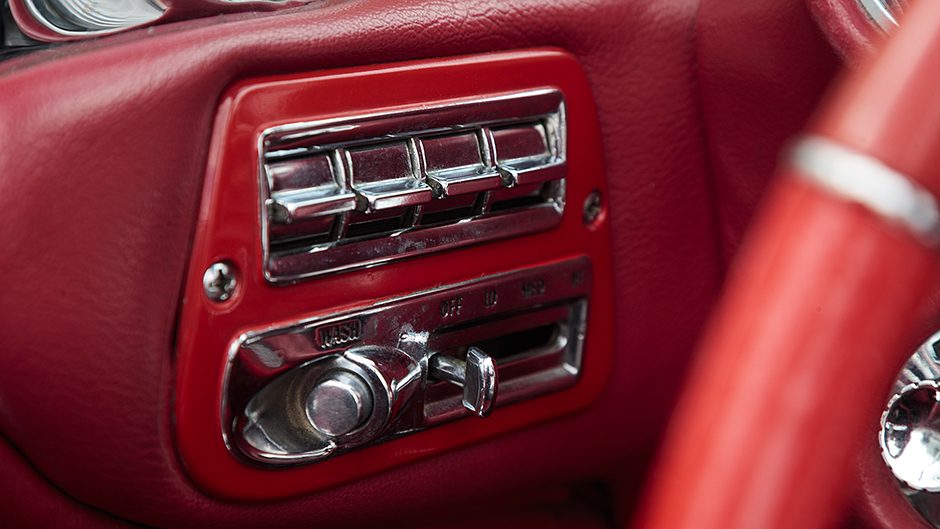
It therefore represents Cadillac design at the height of both its grandeur and its absurdity. Its place in the cultural lexicon is confirmed by the way that a ’59 Caddy is instantly recognisable. We’ve all seen that sleek, long, imposing shape many times before. We’ve witnessed it in hundreds of movies, and seen it printed on millions of T-shirts. It has even decorated US postage stamps. There probably isn’t a more quintessential artifact of 1950s Americana.
So when Hamilton transport engineer, Robin Ratcliffe, was designing a house to be built upon a ground floor comprising a six-bay garage, one of those six cars within had to be a 1959 Cadillac. With this unique structure now built, other current inhabitants include a pair of contemporary BMW saloons, a rambunctious 1930 Ford Model A hotrod, and a 1957 Lincoln Premiere. But it’s the 1959 Cadillac Series 62 Convertible in residence that Ratcliffe most wants to be remembered for.
He and long-time friend, Tom Andrews, were looking at cars on the internet one Saturday morning in 2004 when they came across the Caddy in original condition, with the added provenance of having been owned by a member of publishing magnate Randolph Hearst’s family. The price being asked by Duffy’s Classic Cars was a then eye-watering $US75,000.
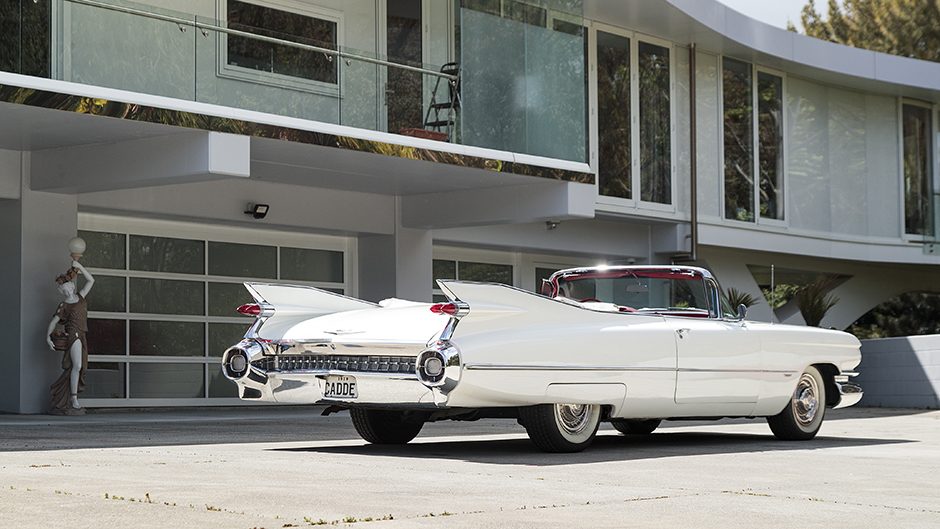
“I said to Tom – that’s a lot of money – and he said that ‘grandchildren can always remember grandad’s car’. So I said ‘bugger it, we’re going to buy it.’
“I got Duffy’s to send through some photos, showing the underside of the car and the seats and interior, and it looked pretty good, so I sent through the invoice.
“Tom had a car to ship back from up there (the US) as well, so we put them both into a container – it didn’t arrive for about seven months.
“When it finally turned up, we opened the doors to find that both cars were completely covered in mould.”
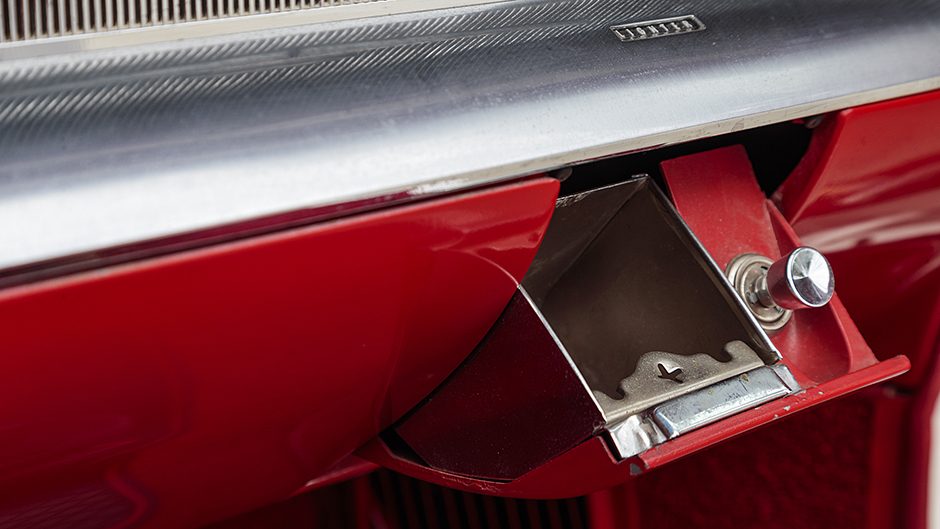
The Cadillac had only travelled 7000 miles on Californian roads, and it fortunately scrubbed up pretty well. After getting complied, it was put in the custodianship of late Robin’s father-in-law, Merv Pearson.
“I was building the house, and he had been diagnosed with cancer, so I told him to look after it for us at the beach house in Waihi, and to drive it around like it was his own.”
Driving a 1959 Cadillac around the beachside town was the fulfillment of a long-held dream for the now-departed Merv.
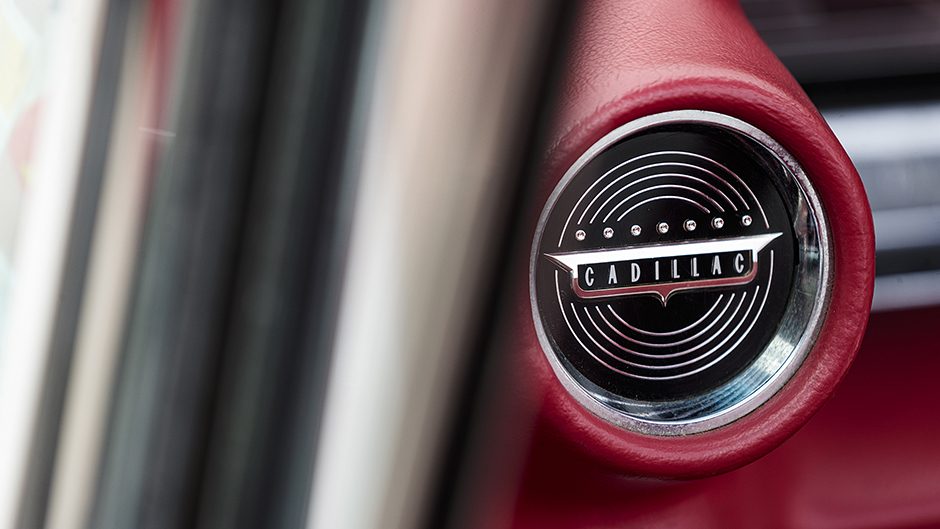
No doubt the iconic design of the car triggered both Merv’s and Robin’s initial fascination with it. The ’59 Caddy will always have a place in GM automotive history as the ‘requiem for MisterL” – MisterL being the preferred moniker of Harley Earl. Yet the 1959 Cadillac owes its low-flying-missile looks more to Earl’s successor, Bill Mitchell, than to the great man himself.
The story starts with Earl taking a long sabbatical from GM to tour Europe, with the design sketches of the 1959 models for all GM’s divisions already signed off. Mitchell was placed in charge of GM’s design team in Earl’s absence, and he was concerned that the firm intended to release the same basic designs for 1959 with just a few extra details added to set them apart from the previous year’s models. This was following GM’s shareholder-friendly wisdom of the time, as each car body was meant to last two model years, and the ’58 models had been brand-new designs.
The big threat was the latest Chrysler range, which appeared to be establishing a new aerospace-inspired design language for American cars. Many were predicting this styling would set the trend for the coming decade, the 1960s. Mitchell thought that GM needed to make a more emphatic statement of its market leadership at the closing of a decade, and soon convinced GM’s management that a new approach was needed.
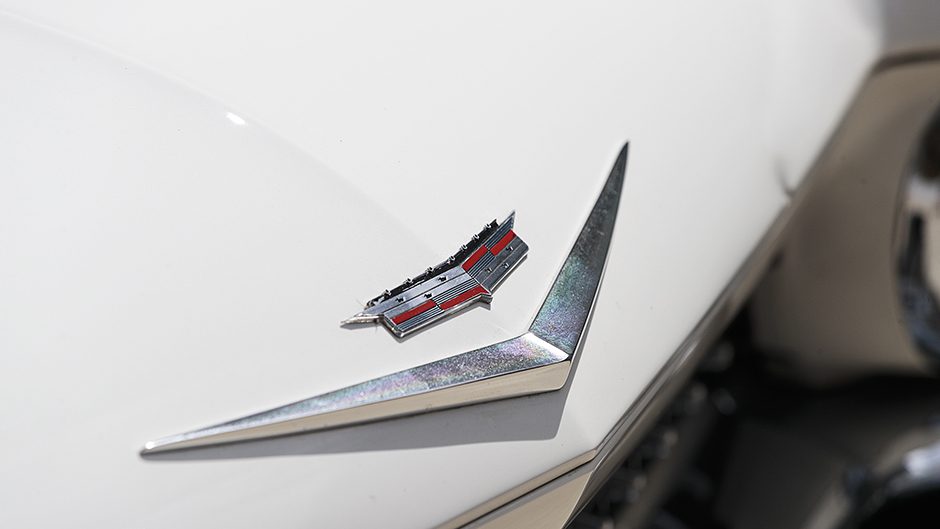
Chrysler had introduced the “100 million dollar forward look” design theme in 1957, with an ad campaign proclaiming slogans like “suddenly, it’s 1960” and boasting that the company was “three years ahead of the other two”. The biggest threat to Cadillac was the ’57 Chrysler Imperial, which featured new design elements like curved side glass and lower-mounted headlights with front fender ‘eyebrows’. With the Imperial now presenting a more luxurious image, it was clear to Mitchell that Cadillac would lose its reputation for design leadership if they proceeded with the bulkier-looking cars that Earl had already approved.
Management agreed, and not only was the green light given to a new design direction, but the new Caddys would also have a new platform and powertrain. It would have surprised no one had there been hallucinogenic drugs placed in the coffee machine of the GM design studio at the time given the radical ideas that were being explored for the ’59 model range. The early design studies for Buick models featured dorsal fins on their trunk-lids, flanked by a huge tail-fin on either side, with double-bubble glass roofs.
Fortunately, the Series 62 Cadillac strayed away from such wackiness when it finally emerged, although it still had the most radical tail-fins of any Caddy, those bullet-like taillights, and a front grille that was a direct rip of its equally glittery Chrysler Imperial rival. More important was the new stance of the car on the GM B-body platform that Cadillac now shared with all the corporation’s car divisions. It looked lower than any previous Cadillac.
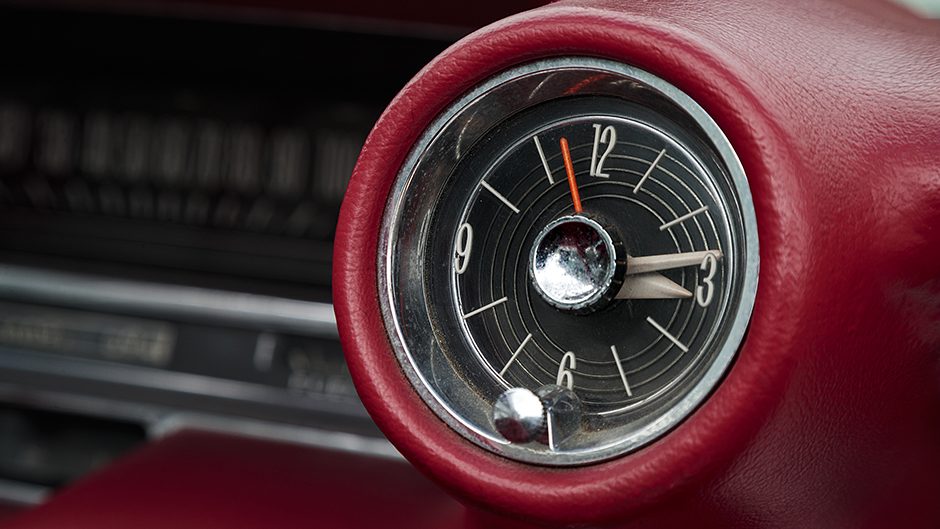
However, the price of the platform technology sharing is that the 1959 Cadillac is technically an ordinary Chevrolet with a more aspirational back end tacked on to it. Although the design gives plenty of trunk space thanks to rear overhang stretch, rear seat space is pretty ordinary. The customary curved windscreen restricts access and egress thanks to the necessary ‘dog-leg’ frame impinging on the front door. So boarding the Cadillac could be quite a challenge, especially for those wearing evening dresses. On a two-door convertible like this one, rips and laddered stockings were often a prelude to a big night out.
When Earl returned from his prolonged leave, he was understandably miffed that something of a ‘palace coup’ had taken place among the 1000 members of the GM design team. However he soon got over it, as ‘longer, lower, sleeker’ had long been his mantra, and he added his own touches to the new Cadillacs to ensure that they had some continuity with the previous models. You can see his influence in the clean side panels of Ratcliffe’s convertible, and the banishment of most of the fussy chrome-plated ‘jewellery’ of the car to the front and rear ends of it.
Mitchell’s team had definitely made the ’59 Cadillac a symbol of American military might in its details. The front grille appears to be comprised of chrome-plated machine gun belts, while the twin nacelles on either side of the bumpers could be the air intakes of a period-correct B-47 bomber. Perhaps they were chosen to remind buyers of GM’s gas turbine-powered concept car.
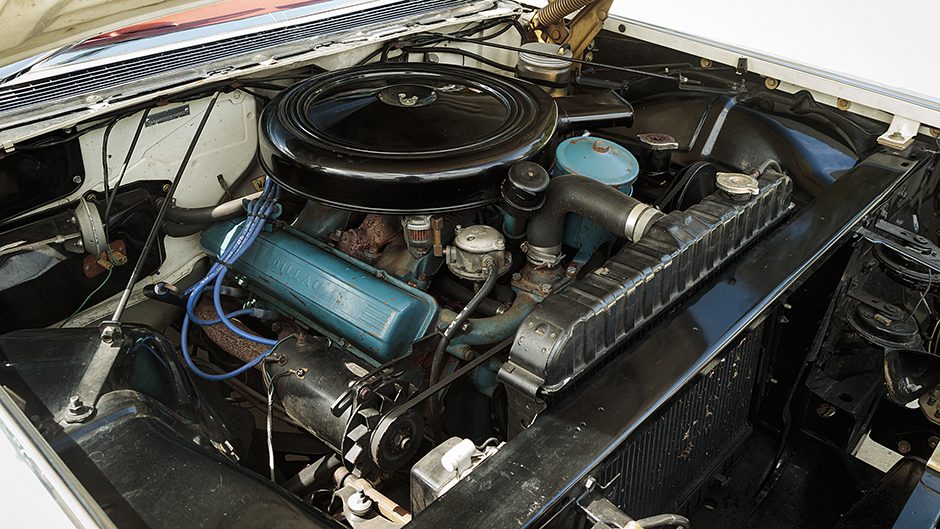
Sorry folks, there’s no gas turbine engine beneath the bonnet of Robin’s ’59, so there’s no afterburner to match those Buck Rogers taillights. Instead, you’ll find the customary 390 cubic-inch (6.4 litre) V8 in residence, pumping 242kW of power. An increase in the stroke of the pistons had added the extra 400cc of capacity over the 6.0-litre units of the 1958 models, while the triple two-barrel carburetors of ’59 Eldorado models took the maximum output of the 6.4 to 257kW.
Robin’s car has had its engine replaced, and the original now resides on a shelf in the garage, as he didn’t want to run up too many miles on it.
Sitting on the famed tubular-steel X-frame chassis, the magic carpet ride of a Cadillac of this period is readily apparent as we move the car around for the photos. Even at such low speeds, there is plenty of suspension movement and weight transfer. Would such roly-poly-ness equate to instability at speed? Not according to Robin.
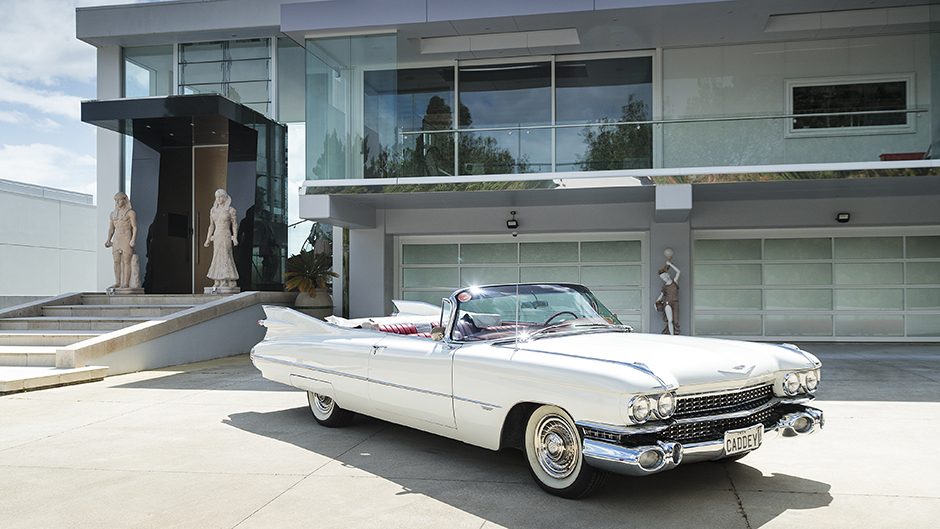
“At first the Cadillac was hard to hold on the road, then someone told me to ‘take those horrible cross-ply tyres off it.’
“I put some radials on it and it became a totally different car – I can take it up to three figures safely now.”
The Cadillac is often used by Robin and wife, Colleen, for trips between their Hamilton home and their holiday house at Waihi Beach. The latter destination being where it used to cruise with Colleen’s late Dad at the wheel.
So this individual car became a ‘requiem for Merv’, while the entire 1959 Cadillac model range became known in the GM legacy as the ‘requiem for MisterL’. Earl, having reached the corporation’s mandatory retirement age, retired just a couple of months after the launch of the 1959 Cadillacs. His replacement was Mitchell, who would embark on a new design direction for the 1960s. The tailfins would shrink away, and simpler, cleaner looking cars would emerge. These would leave the 1959 Cadillac looking wonderfully excessive and decadent, but a fitting epitaph for the flamboyant artist who had led GM’s design for 30 years. When hired by visionary GM president, Alfred P. Sloan, back in 1935, Earl was appointed to head a department called ‘Art and Colors’ and designers were merely the embellishers and decorators of the work of engineers. Under Earl’s reign, the car was no longer a piece of machinery; it became a work of art. This ’59 Cadillac Series 62 Convertible is perhaps the greatest example of that.


